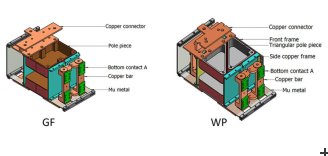Related News
Copyright 2012 neutronsources.org | All rights reserved. | Powered by FRM II | Imprint / Privacy Policy
MagLab expertise puts neutron scattering in focus
Tapping into MagLab expertise on superconductors and cryogenics, a research team built a novel neutron scattering device that is more efficient and produces better data than previous techniques.
Date: 07/12/2016
Source: nationalmaglab.org
Contact: Mark Bird
What did scientists discover?
Scientists who want to probe the structure of a material without damaging it sometimes shoot a beam of neutrons at it, then measure how it deflects off the material. Called neutron scattering, the technique has a couple of downsides because neutron beams are low intensity and difficult to focus.
A team of researchers has found a way to manipulate neutron beams to greatly enhance their utility. Using special tape made of a high-temperature superconductor, they developed a device called a Wollaston prism. By generating a magnetic field that abruptly flips direction at a certain point, the device splits a neutron beam into two beams, according to the spin orientation of the neutrons. One of the beams can then pass through the material under study before being recombined with the other, undisturbed neutron beam, yielding unique information about the internal structure of the material under study. Eventually devices based on this advance might be able to make complete images of the interior of materials with much sharper focus than is available from the familiar technique of magnetic resonance imaging (MRI).
Why is this important?
Neutron scattering is used to study all sorts of materials nondestructively, from archeological relics to high-tech plastics to complex biological structures. This new method gives scientists a more powerful tool for conducting these experiments.
Who did the research?
Fankang Li1, Steven R. Parnell2, Hongyu Bai3, Wencao Yang1, and Roger Pynn1,4
1Indiana University, 2Delft University of Technology, The Netherlands, 3National High Magnetic Field Laboratory, 4Oak Ridge National Laboratory
Why did they need the MagLab?
Superconductors can carry a large amount of current with zero resistance. In addition, magnetic fields cannot penetrate them. These properties allowed scientists to use superconductors to generate a large and very uniform magnetic field within the well-defined boundaries of the Wollaston prism. MagLab expertise in magnet design and construction using high-temperature superconductors was critical to the successful assembly of these devices. The Magnet Lab is currently designing and building several other powerful, new magnets featuring cutting-edge, high-temperature superconducting technology.
Details for scientists- View or download the expert-level Science Highlight, Neutron spin control on the road to real-space neutron imaging
- Read the full-length publication, Spin echo modulated small-angle neutron scattering using superconducting magnetic Wollaston prisms, in J. Appl. Cryst.
- High Field Magnet at HZB: https://www.helmholtz-berlin.de/quellen/ber/hfm/hfm/index_en.html
Funding
This research was funded by the following grants: G.S. Boebinger (NSF DMR-1157490). Construction of the device was funded by Oak Ridge National Laboratory Directed R&D as part of neutron instrument development.



